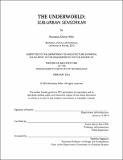The underworld : sub-urban sensorium
Author(s)
Hiller, Anastasia Diane
DownloadFull printable version (48.10Mb)
Alternative title
Sub-urban sensorium
Other Contributors
Massachusetts Institute of Technology. Department of Architecture.
Advisor
Antón García-Abril.
Terms of use
Metadata
Show full item recordAbstract
The underground has been typically viewed as a utilitarian space of expansion. Modernism has required an infrastructural underground, seen as a space of necessity. Historically, the underground has been a place of ceremony and ritual, an otherworldly escape from reality, inhabited by the literary, carceral or religious. The contemporary city calls for a reassertion of this ceremonial underground, extending beyond the infrastructural impulse. With populations rising, and land a finite commodity, the body and city call for a new space- unachievable at grade. The city with its many noises, sights and smells needs filtration. This thesis invites an exploration of the underground, and brings into question conventional disciplinary acts of representation. Working within the underground requires a different set of architectural operations. The underground offers a freedom from existing architectural conventions. Carving becomes the tool of the architect, as the underground relies on excavation to create space. The underground becomes a zone of expression, whose qualities releases us from the banality of orthogonality, as it is a substance that must be carved. The underground enables the refusal of the rationalization of the city. While mediating the path of the person the underground public space offers a sensorium to explore, not a labyrinth to merely follow. This proposal allows for different experiential conditions not found typically at grade, through manipulations of the perception of light, sound, materiality and depth. In working within the constraints of no light or air, and construction by subtraction, architectures of transition become how one moves through the project. Thinking underground is an exercise in total interiority, and provides an opportunity for reorienting the senses, through sequencing, light and scale. Entering the world of the subterranean subverts the visual dependency, as physical sensation underpins spatial cognition. This thesis positions the underworld as an unadulterated, highly stimulating and sensorial experience.
Description
Thesis: M. Arch., Massachusetts Institute of Technology, Department of Architecture, 2016. This electronic version was submitted by the student author. The certified thesis is available in the Institute Archives and Special Collections. Cataloged from student-submitted PDF version of thesis. Includes bibliographical references (pages 161-167).
Date issued
2016Department
Massachusetts Institute of Technology. Department of ArchitecturePublisher
Massachusetts Institute of Technology
Keywords
Architecture.